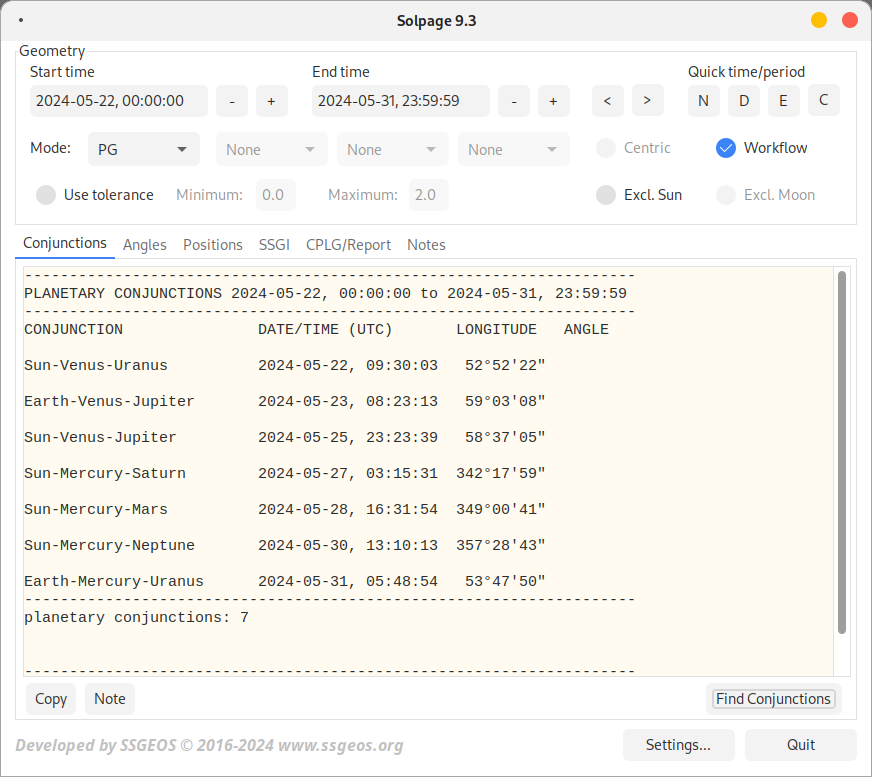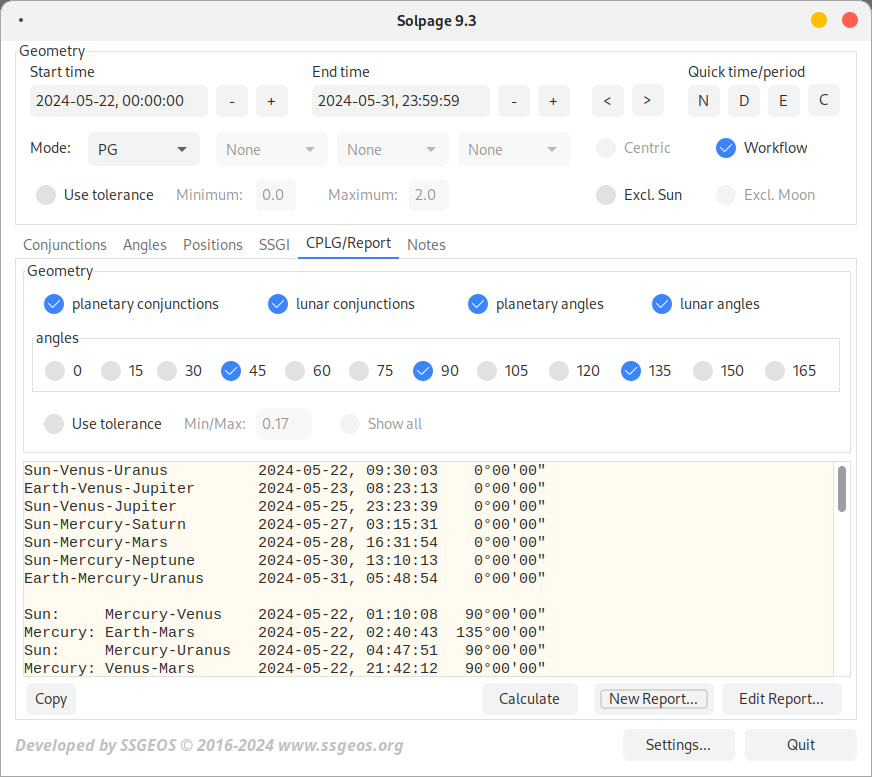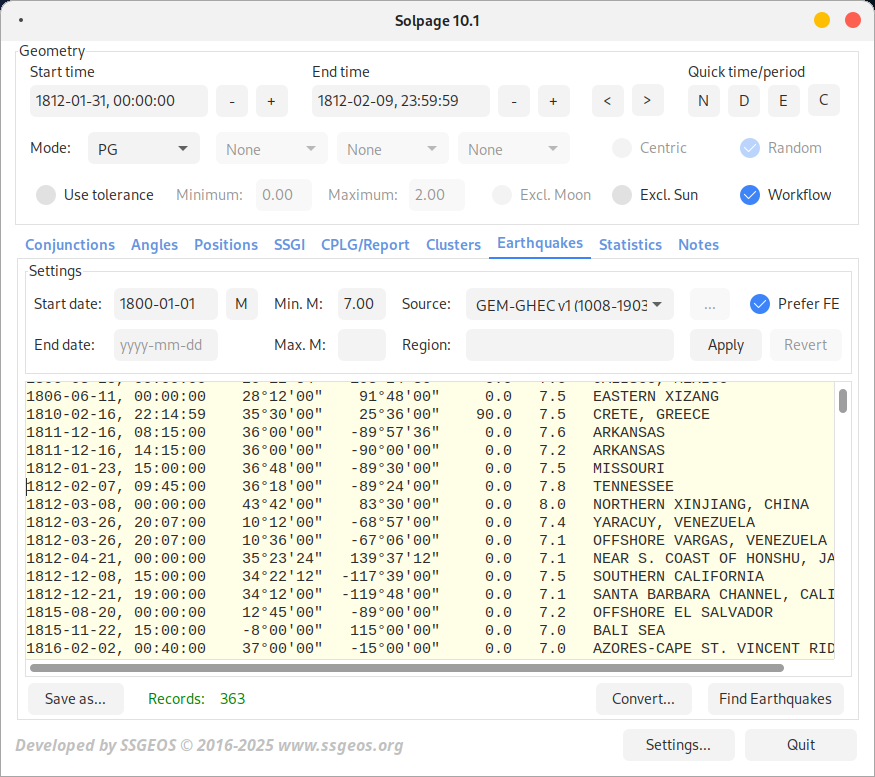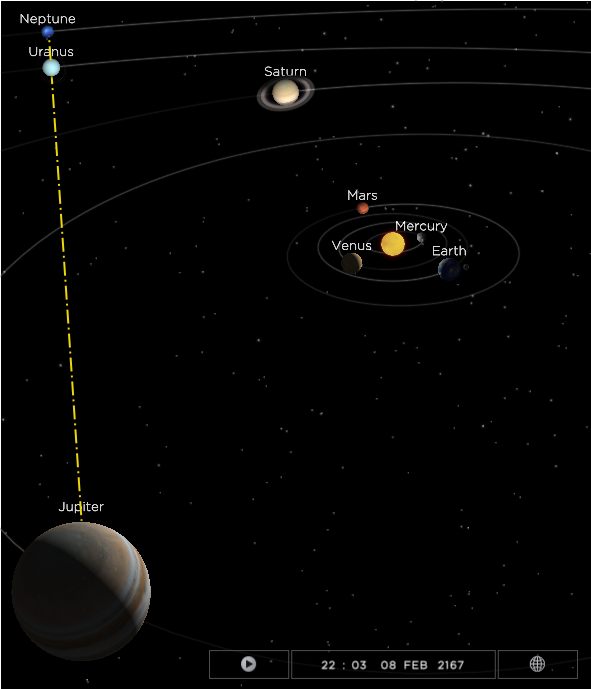Solpage
Solpage is a multi-platform software program written in Pascal and developed by the SSGEOS. It computes planetary positions, angles, conjunctions and geometric clusters for a given date or time-frame using the periodic terms of the VSOP87 solution. Graphical representations of planetary and lunar geometry are provided by the SSGI module. Solpage can generate earthquake reports for the web, collect earthquake data and calculate statistics (as of version 10). The name "Solpage" was originally derived from SOLar system Planetary Alignment GEnerator, which was its initial purpose. But as the program developed beyond this basic functionality, it gradually lost that meaning. Today the name is considered very apt for its research purpose being focused on or "on the page of" the Solar System.

Solpage v9.3 on GNU/Debian Linux 12.
History
Software development started in February 2016. Initially only the conjunction computation engine was developed. This engine computes the exact time when two celestial bodies reach the same longitude relative to a third, centric celestial body. Throughout 2016 this engine was corrected and optimized to handle 8 decimal digits precision and to prevent "jumping over conjunctions" with the fast moving celestial bodies Mercury, Venus and the Moon.
In October 2016 the listing of positions and angles for a given time and centric view was added.
In November 2016 more features were added, the most important of which was the possibility to lookup combinations of different angles in a given time-frame.
In July and August 2017 the first Solar System Geometry Index (SSGI) algorithm was added in an attempt to increase the accuracy of earthquake forecasts. This algorithm was revised and extended several times in the following years.

SSGI calculation tab in Solpage v9.3 on GNU/Debian Linux 12.
In February 2020 Solpage reached version 6. Some code was optimized. Several options were added to make the program more convenient to use and to allow for more selective data to be generated.
With the release of version 7 in September 2020, Lunar sub-geometry (LSG) was added, both to the angles tab as well as to the SSGI algorithms. Some experimental options, such as wide planetary geometry (WPG) were added in subsequent minor versions during 2020 and 2021.
As of version 7.4, which was released in September 2021, some SSGI algorithms were further categorized into Mercury-specific (PGme), Venus-specific (PGve) and general planetary geometry (PG). This way, the resulting SSGI graphs make directly visible which geometry is predominant.
In September 2022 a significant relationship between Mercury and Venus was analyzed and found to potentially trigger major earthquakes that could not be explained previously, like in June 2020. This geometry, after being added to the SSGI algorithm in November 2022, was put to the test in January 2023 when Mercury and Venus reached 90° with Uranus on the 7th and 8th respectively. Major earthquakes indeed occurred on 8 and 9 January (peaking magnitude 7.6).
As of December 2022, with version 7.8, lunar geometry is depicted on the common SSGI graph in more detail whereby the traditional lunar peaks (green) are now depicted as MLG (mean lunar geometry).
With the revisions in the second half of 2022, which completes a development period of 9 years, we believe that most of the significant planetary and lunar geometry has been mapped.
With major version 8.0 in May 2023 a reporting system was added in order to speed up earthquake report generation for the website.

SSGI report tab in Solpage v9.3 on GNU/Debian Linux 12.
In August 2023 parts of the Solpage interface were redesigned. Most notably, the interface was enlarged and certain settings rearranged in order to improve the look and features accessibility. This long awaited interface upgrade came with major version 9.0.
In March 2024, with minor version 9.3, planetary geometry involving Earth (PGea), especially in combination with Mercury and Venus, was added to the SSGI COMMON algorithm and is depicted by blue peaks. Subsequently, New Moon and Full Moon are shown as blue peaks in addition to the lunar (green) peaks. Additionally, some SSGI filters were added.
After several beta-versions, version 10 was finalized in December 2025. It has upgraded SSGI graphs showing curved peaks, introduces new features such as cluster detection, earthquake data processing with integrated FE-naming conversion, and statistical analysis.

Earthquake tab in Solpage v10.1 on GNU/Debian Linux 12.
Version 10.1 in December 2025 added additional earthquake catalog conversion support, including full NOAA Significant Earthquake Database import with proper M -> MI conversion using 2025 ISC-GEM/INGV/USGS consensus calibration. Catalogs from GEM-GHEC, ISC-GEM, NOAA and USGS can now be imported and are automatically converted to FDSN format, the standard used by Solpage.
Unique
While most planetary geometry computation software (typically astronomy and astrology software) is limited to heliocentric and geocentric positions, emphasizing observations from Earth, Solpage is unique in that it supports any centric view. For example, what are the positions of the planets from a Mercury-centric perspective, i.e. as seen from Mercury? And what are the positions from a Venus-centric perspective? The most important centric views in our research are from the Sun (heliocentric), Mercury, Venus and Earth (geocentric). The limitless centric view feature is one of the main reasons why the Solpage project was started.
Example
As an example we ask Solpage when Jupiter, Uranus and Neptune will make an exact conjunction between 1 January 2000 and 31 December 2199. With a Jupitercentric search, the program finds one match:
2167-02-08, 22:03:59 301°21'55"
So according to Solpage the next time Uranus and Neptune are conjunct as seen from Jupiter is on 8 February 2167 at 22:03:59 UTC, when the longitude of both planets reach 301°21'55". Below is a screenshot taken from Solar System Scope depicting the planetary positions on 8 February 2167 at 22:03 with the conjunction marked by the yellow line.

A rare conjunction of Jupiter, Uranus and Neptune, 8 February 2167
Speed
The computation of the above example was first done on Manjaro Linux 17.1.11 using an Intel Core 2 Quad Q9550 2.83 GHz processor. It took Solpage about 5 seconds to scan 200 years and display the result. The most recent test was on Debian 12 with an Intel Celeron dual core G4930 3.20 GHz processor and covered the period from 1 January 1990 to 31 December 2199 (210 years). Solpage did the computation in 13 seconds and found two maches:
Jupiter-Uranus-Neptune 2167-02-08, 22:03:59 301°21'55"